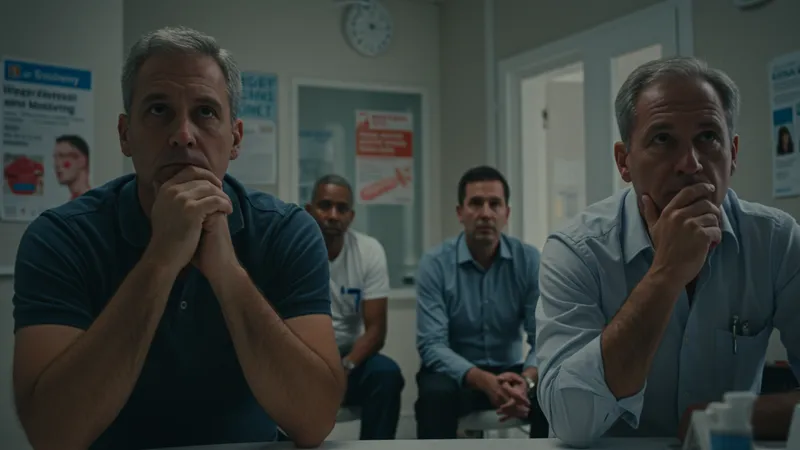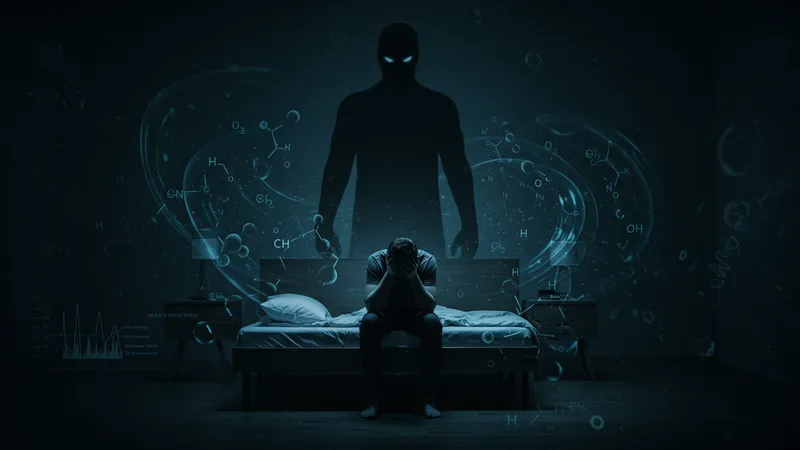Would you believe if I told you that more than half of what the internet says about erectile dysfunction is just smoke and mirrors? Yes, you've been fed myths that could derail your relationships and self-esteem.
In a time where misinformation spreads like wildfire, knowing the truth about erectile dysfunction isn't just enlightening—it's essential for your well-being and relationships. Discover what you've been missing out on!

Surprised to learn that erectile dysfunction is not just a problem for the older generation? Many falsely believe it's solely age-related. In reality, stress and lifestyle choices are rapidly elevating its prevalence among the young. But that’s not even the wildest part…
There's a massive myth that medication is the only fix. Pharmaceutical giants have marketed their drugs to the point of overshadowing other potent remedies. From unique therapies to unexpected lifestyle tweaks, the solutions are as diverse as they are surprising. But hold on, because that’s not the end of the tale…
Experts are absolutely baffled, but there’s a twist that might just turn everything you know upside down. What happens next shocked even the experts…
One of the biggest myths around erectile dysfunction is that it only affects older men. Recent studies demonstrate that a staggering 25% of new patients with erectile dysfunction are under the age of 40. This age shift is reshaping how we think about this condition.

Society's misconception about age and ED has led younger people to ignore symptoms and delay treatment. They wait for years, believing "it will pass." However, addressing the condition early could drastically improve quality of life and even intimate relationships.
Misunderstanding ED as an inevitably age-related condition results in missed opportunities for early interventions. Young individuals feel embarrassed or stigmatized, leading to a detrimental cycle of anxiety and avoidance.
The age factor is just one piece of the puzzle, though. The next part of this series will make you question everything you thought you knew about lifestyle and its hidden impact on ED.
It's not just bad luck or genetics. Lifestyle choices might just be the smoking gun in the rise of erectile dysfunction, especially among youth. A sedentary lifestyle combined with processed foods rich in sugars and unhealthy fats is fueling a quiet crisis in men's health.

Increased consumption of alcohol and tobacco compounds the problem, both affecting blood flow and vascular health. These aren’t just social habits—consider them silent saboteurs of a healthy intimate life.
People often ignore how simple changes like regular exercise can be a game-changer. Studies highlight a 40% improvement in erectile function with consistent physical activity—a compelling case to rethink lifestyle priorities.
But here’s another layer that’ll surprise you: the link between screen time and intimacy issues is more significant than ever expected. Dive deeper as we uncover the underbelly of digital distractions.
Stress and anxiety—silent yet potent contributors to erectile dysfunction. Unlike physical causes, these psychological factors fly under the radar, making them all the more insidious.

Chronic stress elevates cortisol levels, which in turn affect testosterone production. This hormone imbalance can wreak havoc on libido and arousal mechanisms, esspecially in crisis-heavy periods when stress spirals out of control.
Men caught in this stress-induced cycle often experience performance anxiety. It is a feedback loop where fear of failure perpetuates its realization, further entrenching the problem.
Interventions such as mindfulness and cognitive behavioral therapy have shown promising results. But there’s a financial myth tied to these interventions, something you wouldn’t guess. Stay tuned as the story unravels more financial mysteries.
One persistent myth is that effective treatments for erectile dysfunction are prohibitively expensive. The high cost of branded pharmaceuticals contributes to this perception, but generic options and alternate therapies are often overlooked.

Breaking down financial barriers reveals that many misjudge the actual costs. Insurance coverages and health savings accounts can significantly offset out-of-pocket expenses for both drugs and therapy.
Alternative therapies, from herbal supplements to lifestyle adjustments, often offer budget-friendly avenues for combating ED without sacrificing efficacy. These pragmatic options shed light on a more financially accessible route to well-being.
Still, the narrative isn't complete without a twist, and what comes next in our deep dive opens up an explosive aspect of technology's role—one that shines a bright light on untapped possibilities.
Emerging technologies are revolutionizing treatment approaches, offering innovative solutions that were unimaginable a decade ago. From advanced wearable devices monitoring health metrics to telehealth platforms facilitating remote consultation, the future is here.

Smartphone apps provide reminders for medication, deliver stress-relief guidance, and tailor personalized health plans. One app even utilizes AI to predict and prevent erectile dysfunction based on early signs.
The rise of telemedicine is bridging the gap for those hesitant to seek traditional consultations due to embarrassment or accessibility issues. AI-driven diagnostics streamline the process of identifying viable treatment pathways with unprecedented accuracy.
But beyond tech-savvy solutions lies a controversial question—is privacy at risk with data-driven healthcare? Our next segment is sure to stir dialogue on this critical trade-off.
The integration of AI in healthcare heralds efficiency and precision, yet raises significant privacy concerns. Personal data collection remains an area of apprehension for users apprehensive about confidentiality breaches.

It's a balancing act: enjoying the benefits of personalized care while safeguarding personal privacy. App developers and healthcare providers must prioritize robust data protection mechanisms to maintain trust.
While AI diclosure is a looming threat, secure systems and informed consent help alleviate concerns. Patients must demand transparency in data handling as part of their healthcare ecosystem.
Curious about the chaos or calm that AI's footsteps bring in other health domains? The answers aren’t obvious, as our next section will illuminate unexpected arenas impacted by AI.
The ripples of AI reach far beyond erectile dysfunction, touching new boundaries across diverse health areas like predictive genomics and mental health monitoring. Precision medicine is on the cusp of becoming everyday reality thanks to AI.

Chronic conditions like diabetes and hypertension are seeing novel interventions afforded by AI—aiding in tailored treatment plans and real-time adjustments for patients that improve outcomes exponentially.
Mental health services capitalize on AI's adaptive algorithms, providing timely interventions and support for conditions like depression and anxiety, reshaping how we approach emotional and psychological care.
However, the debate continues: how can emerging tech coexist with traditional healthcare models in harmony? Explore this twist, revealing friction and synergy in our subsequent exploration.
Modern technology doesn’t merely aim to replace traditional medicine; instead, it enhances and complements it. The synergy between hands-on care and tech innovations offers profound opportunities for holistic care.

Medical professionals now face the challenge of integrating these advanced tools into conventional practices, revolutionizing patient care methodologies and expectations.
Yet, skeptics voice valid concerns over the depersonalization of healthcare. How do we balance the warm empathy of practitioner care with the cold efficiency of machines without losing our touch?
As we continue, ponder this: Is there a sweet spot between intuition and machines that humanity has yet to fully actualize? The forthcoming pages promise to spark excitement and introspection alike.
Cultural narratives profoundly shape understanding and attitudes toward erectile dysfunction. Social taboos persist, overshadowing scientific facts with folklore and hearsay, often rooted in cultural misinterpretations.

Misleading cultural icons and stories perpetuate falsehoods about masculinity and prowess, embedding misconceptions that stigmatize seeking help.
Educational campaigns must cater to these cultural nuances, implementing sensitivity training to break down barriers and open avenues to factual conversations.
Before we wrap this cultural exploration, stay tuned as we dive into the success stories—dimming the stigma's shadow with real-world transformations.
Behind the statistics are real stories—testimonials of men who overcame erectile dysfunction through varied and innovative means. Success stories exemplify the power of informed choices and access to diverse treatment avenues.

From lifestyle overhauls that rejuvenated libido to groundbreaking therapies yielding newfound confidence, these transformations challenge assumed norms.
Special attention goes to those leveraging community support and mental health care, highlighting the broader scope of collective healing.
Astonishing outcomes await as we gear up to share the layers of evolution—will you take this path to discover resolutions within reach?
A supportive community acts as a cornerstone for individuals navigating erectile dysfunction. Fear and stigma diminish through collective understanding and empathy, revealing avenues for acceptance and empowerment.

Peer support groups foster a safe space for shared experiences, normalizing discussions that were once considered taboo and taboo.
Public forums amplify voices and narratives previously confined to whispers, advocating widespread enlightenment and reformation.
But is community awareness alone enough to dismantle entrenched ideologies? Explore further as we investigate pivotal strides towards impactful social transformations.
On the horizon are breathtaking innovations transforming erectile dysfunction care. From gene editing to revolutionary therapeutics, these advancements hint at possibilities once thought unattainable.

Virtual reality and immersive therapies offer unforeseen therapeutic benefits, creating simulated environments that stimulate psychological and physiological responses.
Gene therapy is making headlines as scientists explore genetic pathways to remedy sexual dysfunction, hinting at a not-so-distant future where genetic predispositions are no longer deterministic.
Anticipate the next wave of exploration, where innovation meets ethical consideration—will tomorrow’s breakthroughs redefine today’s limitations?
And there you have it—a profound voyage through myths and truths surrounding erectile dysfunction. The insights and revelations uncovered reveal both the surprising myths and hopeful horizons.
Challenge perceptions, share these eye-opening discoveries, and embark on this journey towards a healthier, more informed world. Don't keep this knowledge a secret—share it, and together, let's rewrite the narrative.